
 United Kingdom – Aircraft Carrier
United Kingdom – Aircraft CarrierWW1/WW2 RN Aircraft Carriers:
ww1 seaplane carriers | Ark royal (1914) | Campania | Furious | Argus | Hermes | Eagle | Courageous class | Ark Royal (1936) | Illustrious class | Implacable class | Colossus class | Majestic class | Centaur class | Unicorn | Audacity | Archer | Avenger class | Attacker class | HMS Activity | HMS Pretoria Castle | Ameer class | Merchant Aircraft Carriers | Vindex class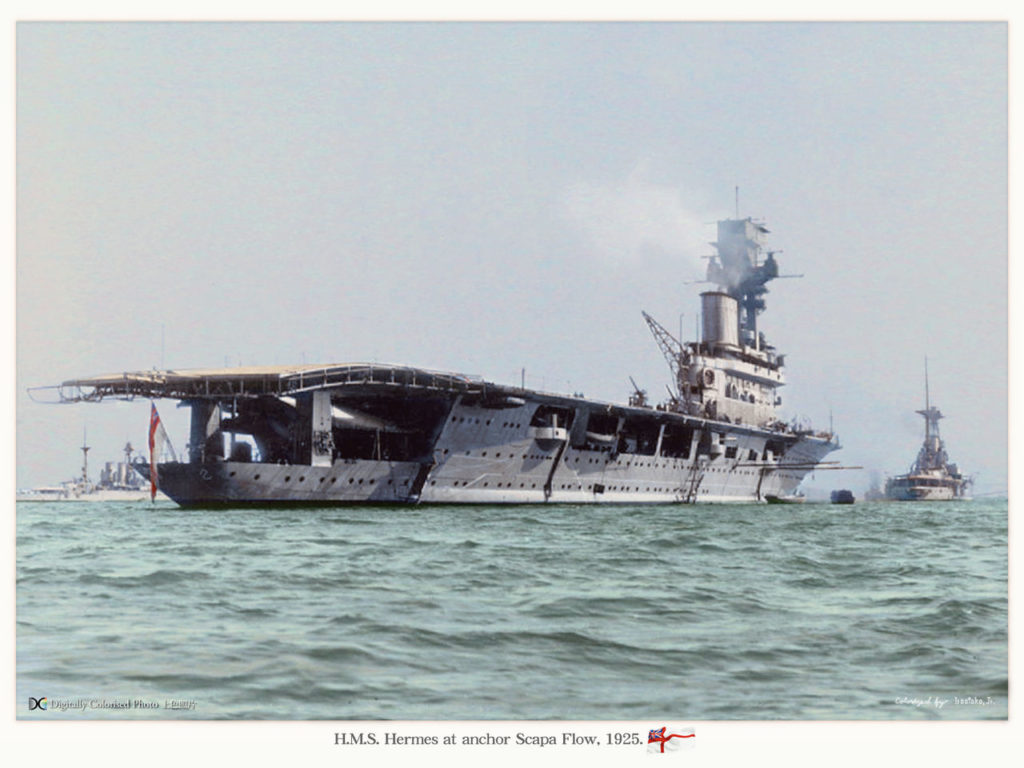
HMS Hermes was the first (or second depending on the authors) purpose-built aircraft carrier. Indeed the Imperial Japanese Navy claimed to have the first, IJN Hosho. However, the latter was started AFTER the British carrier, but launched and completed before. Engineers and yard’s team were in a rush as a matter of prestige. Since the Anglo-Japanese alliance of 1902, indeed, the IJN naval staff was always the best informed of the latest innovations by the Royal Navy.
Anyway, the HMS Hermes was a formidable achievement. At a time the aircraft carrier was an idea pioneered and pursued almost solely by Great Britain, being the first to use an operational aircraft carrier, the HMS Furious alongside a collection of converted seaplane and aircraft carriers. Even before the Furious launched her first missions, the admiralty thought of developing a ship tailored for the task, better suited than converted ships it had until there. Unfortunately, from the laying down of the keel in February 1918 to completion, world war one was over. It was no longer required, but already the Admiralty went too far to back up.
She was a too interesting experimentation alongside the HMS Eagle to drop, moreover the Washington treaty soon gave almost free hands to further develop the concept. Launched way sooner than the Eagle (1919 vs. 1924), HMS Hermes had a long interwar career and was still (almost) in her unmodified form when WW2 broke out.
This proved a problem as many innovations has seen the light of day in between, notably the size and power of the planes themselves of the little us of secondary artillery. The ship appeared too cramped to possess an effective air group in WW2 standards. Nevertheless, she served in the Mediterranean, Near East, and Indian Ocean, and died while trying to join Force Z en route for Singapore. She was intercepted by a wave of Japanese Bombers, taking more than 40 bomb hits before sinking.

Design genesis of HMS Hermes
The first draft of the ship called for a mixed wheeled aircraft/seaplanes carrier, but based on a cruiser-type hull as reflecting by war experience since 1914. The IJN arrived at the same conclusion and the IJN Hosho proceeded from the same basic principle. The basis went back to 1916 seaplane carrier design by Gerard Holmes and Sir John Biles.
1916-17 first drafts
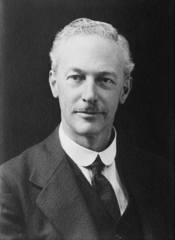 However as the war progressed and returns from various seaplane carrier conversions arrived, Sir Eustace d’Eyncourt, the Director of Naval Construction (DNC), took back the project and enlarged it considerable.
However as the war progressed and returns from various seaplane carrier conversions arrived, Sir Eustace d’Eyncourt, the Director of Naval Construction (DNC), took back the project and enlarged it considerable.
Indeed the first drafts thought to use the hull of one of the Hawkins class heavy cruisers just started. His design was finalized in April 1917. His most prominent feature were a split section seaplane slipway. There were indeed quite a unique arrangement to track and guide the planes to their deployment area from the hangar storage to launch position. A feature found in many other early aircraft carrier designs but dropped out of practicality and moreover versatility.
D’Eyncourt rigid submerged portion aft had a trolley to carry the aircraft into the hangar and flexible submerged portion, separating the rear section from the forward portion of the slipway. This was to prevent the submerged part from rolling with the ship and this slipway could be retracted into the ship. A massive gantry crane ran all along to recover seaplanes. Also like for the Eagle, two islands were drafted and the full-length flight deck ran in between.
Each island had one funnel and they tended for a large net to recover planes. The latter were lifted from the hangar via two cross-shaped elevators. The forward one made 30 by 30 feet (9.1 by 9.1 m) and aft 60 by 18 feet (18.3 by 5.5 m). The DNC design displaced 9,000 long tons (9,100 t). The aircraft complement comprised only six large Short Type 184 recce seaplanes and six Sopwith Baby seaplanes while the armament comprised six 4-inch (102 mm) guns for close defence.
1918 second draft and blueprints
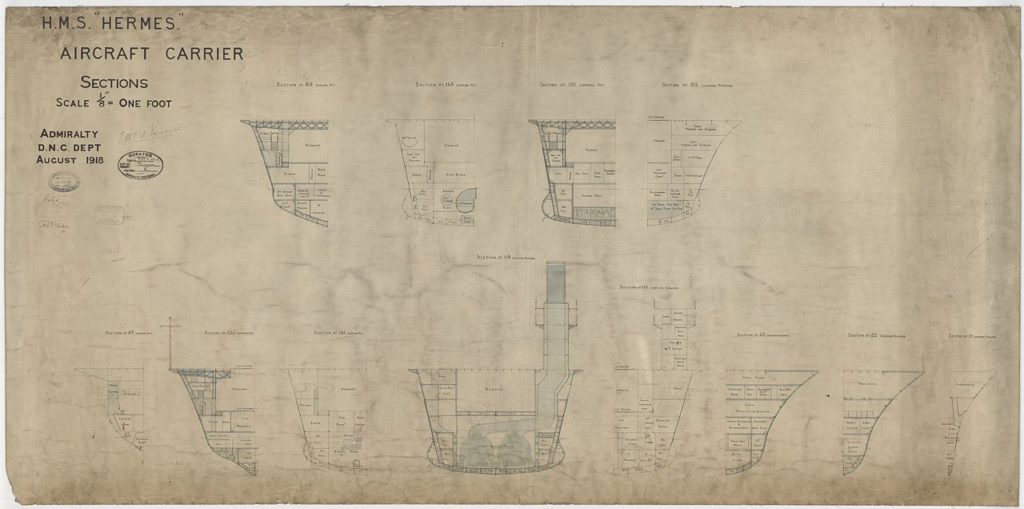
A more detailed design was submitted by the DNC to the admiralty in January 1918, and approved for construction. Changes included and amazing idea of a rotating bow catapult (to launch planes regardless of wind direction). To start construction however, the yard accumulated delays. Resources at Armstrong Whitworth shipyard were however used to complete conversion of HMS Eagle, and despite the keel was laid down this month, little work has been done in weeks.
This slow pace of construction however allowed the design to be refined and by mid-June the slipway had been eliminated ans judge impractical. The armament also has been revised for eleven 6-inch (152 mm) guns, quite an increase, perhaps to make align it on the Eagle, while a single anti-aircraft gun was retained. The admiralty seemed visibly lost in conjectures about the best configuration for an aircraft carrier.
It went so far as forbidding the builder from doing any work above the hangar deck without express permission. In the year’s nearing end, more revisions showed the adoption of a single island while the lifts were changed to a single model, 44 by 20 feet (13.4 by 6.1 m). The armament was revised to an even more powerful ten 6-inch guns and, more fortunately, four 4-inch anti-aircraft guns. Planned displacement rose to 10,110 long tons (10,270 t).
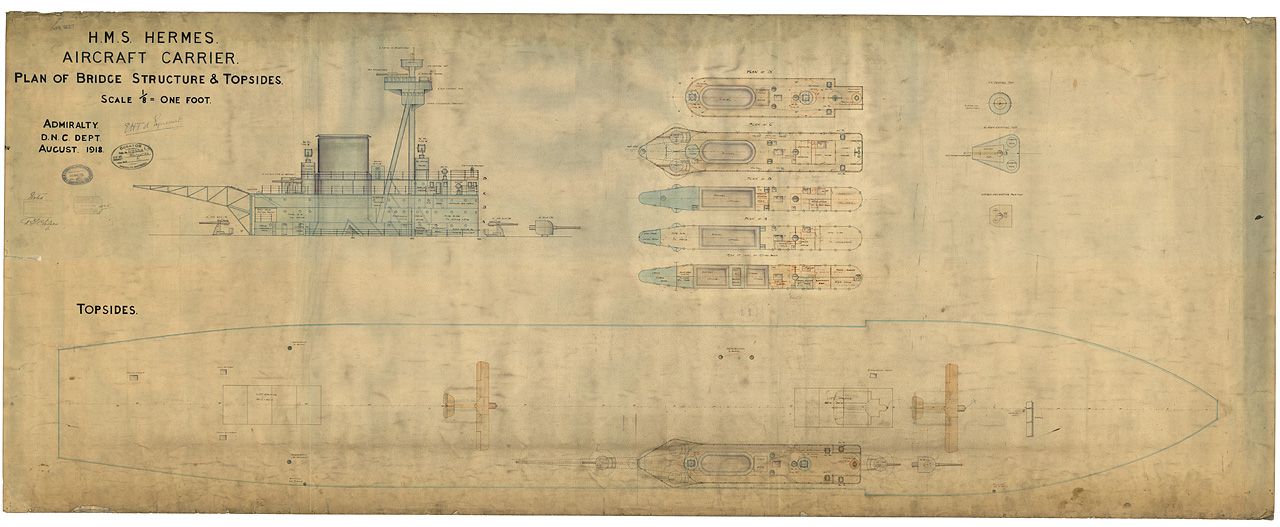
Blueprint of HMS Hermes – island and flying deck
Construction was suspended again just after launch in September 1919. The the Admiralty waited for reports of flight trials on HMS Eagle and Argus. So actually Eagle started operated planed before her custom-built little sister. The design was therefore modified again in March 1920. The island superstructure ad embedded funnel was enlarged and moved to starboard, while the forward catapult was eliminated completely. Like for other carriers, the positioning of the island meant pilots preferred to turn to port after recovering from an aborted landing. The prominent tripod mast integrated fire-control systems for the main guns, same system adopted on the Eagle. In fact both island were really similar in that aspect.
Last revisions came out in May 1921, two years after launch, further delaying completion. Lifts were moved further apart, freeing space for an enlarged arresting gear, and enlarged for next-gen aircraft without folded wings. The main armament was revised down to six 5.5-inch (140 mm) guns to save weight and space, while the flight deck was faired into the bow, just like the Eagle, which made both carriers instantly recognisable to all others to their “gothic” deck, ogival end.

Blueprints of HMS Hermes – side view, last revision in 1918.
Final design of HMS Hermes
As completed, HMS Hermes ws 600 feet (182.9 m) overall, from the stern to the prow, for a beam of 70 feet 3 inches (21.4 m), and a draught of 23 feet 3 inches (7.1 m) deeply loaded. Her lines were fine and there was a steep slope leading to the deck, with the hangar in between. He flight deck was 570 feet (173.7 m) long with 36 by 36.6 feet (11.0 by 11.2 m) lifts, rectangular and not cross-shaped. The hangar was 400 feet (121.9 m) long, but quite narrow, only 50 feet (15.2 m) wide. It was also 16 feet (4.9 m) high, just enough for most planes tails to fit into, but this was a very cramped place.
Hermes displaced 10,850 long tons (11,020 t) standard. The fine line, narrow hull at the waterline and much larger deck proved a liability for stability, and was not repeated. Instead, hulls became larger to accomodate extra ASW protection. However, Hermes had a metacentric height of 2.9 feet (0.9 m). She handled well in heavy weather but with such a large surface area exposed to the wind she required less 25-30° of weather helm at low speed when blowing longitudinally.
Propulsion
The ship was propelled by a cruiser powerplant basically. Her engine rooms accomodated two sets of Parsons geared steam turbines. Each drove one propeller shaft while steam came from six Yarrow boilers at a working pressure of 235 psi (1,620 kPa; 17 kgf/cm2). Total horsepower as designed was 40,000 shp (30,000 kW), and during her sea trials in 1924, Hermes reached 41,318 shaft horsepower (30,811 kW). While her desined speed was to be 25 knots (46 km/h; 29 mph), she reached on trials 26.178 knots (48.482 km/h; 30.125 mph). For autonomy, Hermes carried 2,000 long tons (2,000 t) of fuel oil, enough for 4,480 nautical miles (8,300 km; 5,160 mi) at 16 knots (30 km/h; 18 mph).
Protection
Hermes’ waterline belt was plated over by 3 inches (76 mm) thick plates. Due to the narrow beam, there was limited compartimentation but no room for extra bulk. Her flight deck doubled as strength deck just 1 inch (25 mm) thick in order to avoid stability problems. There was no armour at lower levels, this proved fatal as she was sunk by aviation.
Armament
-Intended for self-defence against enemy warships, Hermes had six BL 5.5-inch Mk I guns, three on either of the hull in sponsons. Thei traverse and arc of fire was about 180°. The BL 5.5 in (140 mm) was a “classic” introduced in 1913 and equipped with a Welin breech block and Holmstrom mechanism. Elevation was -7 degrees to +30 degrees maximal (figures of the mount unknown). Its rate of fire was 12 rounds per minute at a muzzle velocity of 2,790 f/s (850 m/s), and effective range was 16,250 m at max elevation.
-For AA defense, Hermes was given four QF Mk V 4-inch guns (102 mm) positioned on the flight deck, either side of the island. They were unprotected. The Ordnance QF 4 inch gun Mk V used a Breech horizontal sliding-block with an hydro-pneumatic or hydro-spring 15 in system. It fired a 31 lb (14.1 kg) fixed QF rojectile at a muzzle velocity of 2,350 ft/s (716 m/s), and maximum firing range of 16,300 yd (15,000 m) over the surface and ceiling at 28,750 ft (8,800 m). In 1930, this was no longer relevant and the ship’s AA was modernized (see later) several times.
On board aviation
The air complement changed over time in relation to the size of planes and activities. From 1938 she was classed as a training vessel and carried a traning air crew and planes. She would also serve during WW2 as aicraft transport, stacked on the deck. On average it was established to twenty aircraft. Her first 1920s complement comprised Fairey Flycatcher fighters and Fairey IIIDs and later IIIFs. In the mid-1930s whe operated the Hawker Osprey. From 1935 she operated Fairey Seal torpedo bombers. Later she embarked Fairey Swordfish planes when WW2 broke out, to be exact twelve Fairey Swordfish torpedo bombers of 814 Squadron. They could manage reconnaissance, artillery spotting, torpedo and bomb attacks, and in addition carry deep charges.
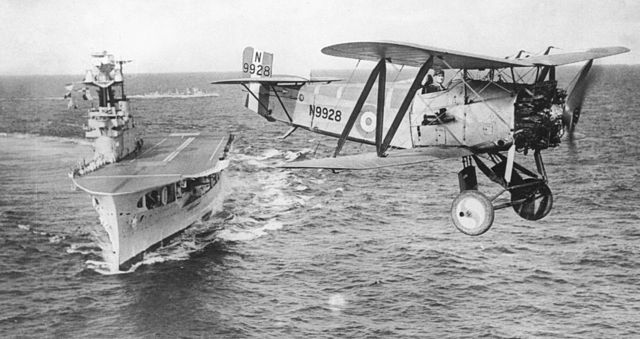
Fairey Flycatcher
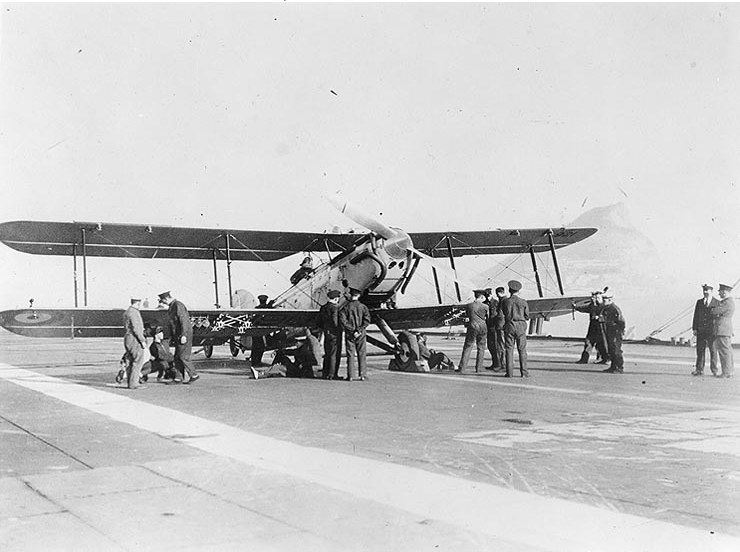
Fairey IIID
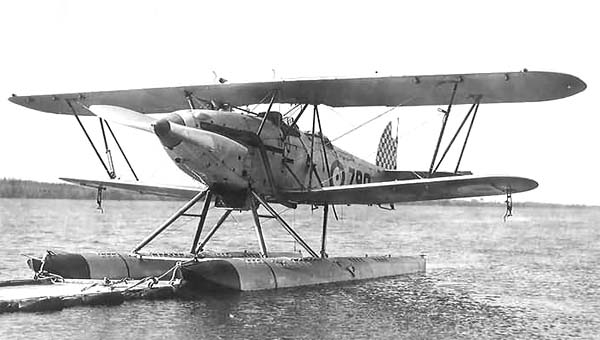
Hawker Osprey
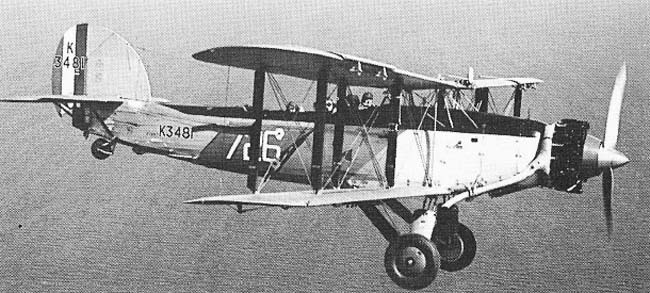
Fairey Seal
Hermes had a longitudinal arresting gear and a large crane was placed behind the island at the origin. The latter was intended to operate seaplanes, which never happened. Afterwards, she was used to lift onboard crates, planes and heavy loads from supply barges or a jetty. Bulk petrol storage for the air group consisted of 7,000 imperial gallons (32,000 l; 8,400 US gal). Her crew comprised 33 officers and 533 men, while the air group, added about 150-200 more in 1939, and even more in wartime.
Wartime career HMS Hermes
HMS Hermes was christened on 11 September 1919 by Mrs. A. Cooper, daughter of Sir Walter Long (First Lord of the Admiralty). The shipyard was scheduled to close at the end of the year so the hull was towed to Devonport, where completion started in January 1920. Hermes was completed gradually. In February 1923n Captain Arthur Stopford took command for the sea trials. She was fitted out, modified and eventually commissioned on 19 February 1924.
Name: Hermes has been the ninth ship called that way, after a 1796 12-gun brig-sloop, 1798 22-gun ship, 1803 16-gun sloop, 1811 20-gun sixth rate, wooden paddle packet, 1835 wooden paddle sloop 74-gun third rate of 1816 renamed in 1866 and 1898-launched Highflyer-class cruiser. The latter became an experimental seaplane tender in 1913 and was sunk in 1914. The name referred to the mythological Greek messenger of the gods, recoignisable to its winged sandals.
It therefore seemed appropriate. After the loss, the name was given to a keel just laid down, future postwar HMS Hermes, R12, modern carrier of the Centaur class in service as flagship during the 1982 Falklands war.
Hermes motto was Altiora Peto (Latin for “I Seek Higher Things”).
Interwar years:
The first campaign of the new aicraft career started with flying trials with the Fairey IIID reconnaissance biplane. Still in 1924, HMS Hermes participated in King George V’s fleet review in Spithead, 26 July. These early trials stressed the need of a short refit until November.
Mediterranean 1925 She was transferred to the Mediterranean Fleet, arrived at Malta on 22 November, and undergone repairs after storm damage en route. She carried her full operarational complement, with No. 403 Flight (Fairey Flycatcher fighters) and 441 Flight (Fairey IIIDs). Hermes conducted flying exercises with HMS Eagle and the rest of the Mediterranean Fleet in early 1925. She then started refit in Malta from 27 March, and afterwards sailed for Portsmouth, arriving on 29 May 1925.
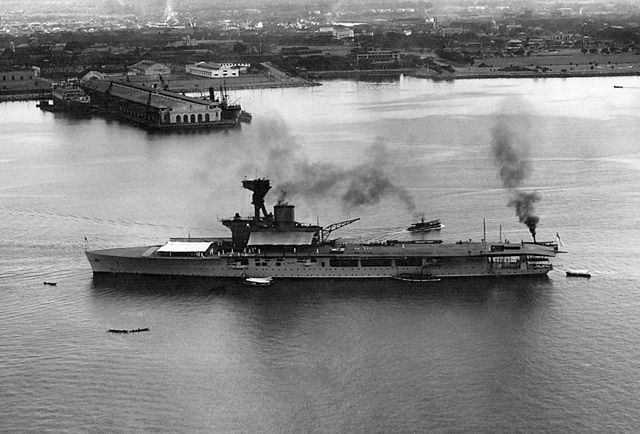
Hermes in Honolulu, circa 1924
China Station (1925-1926): Hermes spend most of her interwar career in the far east. She sailed for the British China Station on 17 June, together with 403 and 441 Flights and stopped in the Mediterranean, while Captain C. P. Talbot took command for the trip. She arrived at Hong Kong on 10 August 1925 and visit Amoy the next month.
Mediterranean (1926): She returned to the Mediterranean in early 1926. She was refitted in Malta April-June 1926. 441 Flight departed for HMS Eagle swapping for 440 Flight and 442 Flight joined in in September, both with Fairey IIIs. After her refit, Captain R. Elliot took command on 14 August. She returned to Hong Kong on 11 October, conducted routine training and then sailed to Wei Hai Wei naval base where she arrived on 27 July 1927.
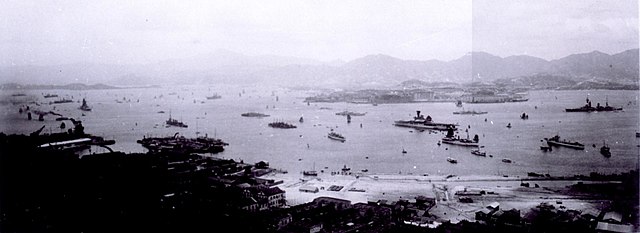
HMS Hermes and the IJN fleet in Hong Kong, 1928
China Station (1927-1929): The ship arrived in September and met Argus on the China Station, but soon both departed to attacked a large pirate base at Bias Bay, the planes strafing and bombing to oblivion a fleet of junks and sampans. HMS Hermes ws back in the United Kingdom on 26 October for a short refit at Chatham Dockyard. One of her 4-inch guns was removed and two single 1.57-inch (40 mm) 2-pounder “pom-pom” AA guns were added, bolstering the AA.
Captain G. Hopwood took command on 2 December as Hermes returned to the China Station on 21 January 1928 and 440 Flight obtained new Fairey IIIFs planes. En route to Hong Kong (reached 18 March), Hermes stopped at Bangkok, inspected by an interested by King Rama VII. Upon arrival she replaced HMS Argus, and then spent time in Chefoo in May 1928 and in Wei Hai Wei, and in July sailed to Chinwangtao. During an exercize, one Fairey IIIF seaplane force landed y the pilot and plane were recused and retrieved by the Italian destroyer Muggia. Hermes also visited Shanghai, Manila, and Kudat and Jesselton in Borneo. Her refit in Hong Kong started in January 1929, and Captain J. D. Campbell took command on 28 March. In April, the British aicraft carrier conducted flying training and sailed the Yangtze River, stopping at Nanking in August. She was back at Wei Hei Wei, visited Tsingtao and Japan and was back to Hong Kong on 29 October until December 1929.
China Station (1930-1937):
From 28 January 1930, Hermes carried the British Minister Sir Miles Lampson to Nanking for talks over the Japanese invasion of Manchuria. She then moved to Shanghai on 2 March 1930 and later this month, was back to Hong Kong. In June she departed for Wei Hai Wei as each summer. She briefly returned to Hong Kong and then sailed to Great Britain by 7 August, and moved to Portsmouth on 23 September, then to Sheerness. Captain E. J. G. MacKinnon took command and after a brief refit at Chatham, Hermes returned to the China Station with the 403 and 440 Flights. She carried in addition on her deck six Blackburn Ripons, planned to be delivered to Malta and HMS Eagle. She was in Hong Kong by 2 January 1931 and departed for Wei Hai Wei for her summer season. She tried to located and rescue the submarine HMS Poseidon but could only save six of the crew, two dying later.
In Wei Hai Wei until late August 1931, she sailed up the Yangtze River, reaching Hankow’s inland port on 5 September, helping the Chinese government’s survey of a massive flooding. Charles Lindbergh and his wife had their own Lockheed Sirius floatplanes parked at the Hermes as a base during the event. They were however damaged by th strong current. Captain MacKinnon carried them to Shanghai for repairs, and departed for Hong Kong. She would rescue survivors of the Japanese merchantman SS Ryinjin Maru lost off Tan Rocks (Taiwan Strait), saving nine crew members. She was then based in Hong Kong from 7 November 1931 to April 1932.
Captain MacKinnon was relieved by Captain W. B. Mackenzie in February 1932, and after a refit, Hermes and HMS Whitehall visited Amoy and joined Wei Hai Wei, staying there until 17 September, sailing to Nagasaki and then to Shanghai, back to Hong Kong in October. In January 1933, Hermes visited the Philippines and was back to Hong Kong for a brief refit, visited Tsingtao and stayed in Wei Hai Wei, before finally departing Hong Kong and sailing for home, reaching Sheerness on 22 July and then Chatham Dockyard. This summer she was opened to the public, and departed for Devonport Dockyard and a major refit: A transverse arresting gear was fitted, machinery overhauled with modernized boilers, two single 2-pdr replaced by two quad 12.7 mm (0.5 in) Mark III machine guns.
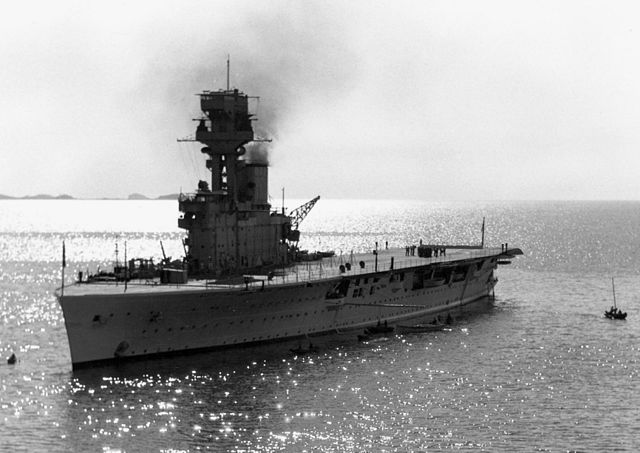
hms hermes, in yantau china 1930
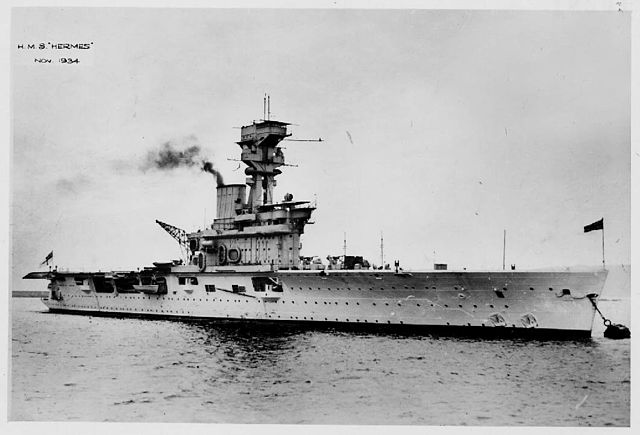
Hermes in 1934 – NH
Captain G. Fraser took command of HMS Hermes 15 August 1934, and the ship made post-refit trials in November. Her air complement arrived soon: 824 Squadron wih nine Fairey Seal torpedo bombers, and she left Portsmouth on 18 November for the usual trip for the China Station, Hong Kong. By January 1935 she was operational with Hawker Osprey of 803 Squadron, transferred from HMS Eagle before leaving Hong Kong to hunt down pirates which captured the British-owned merchant ship, SS Tungchow taking 90 British and American hostages. Hermes’ Seals spotted her in Bias Bay and this was sufficient for the pirates to abandon the ship. Hermes operated off Hong Kong until mid-May and sailed to Wei Hai Wei, remaining there until 12 September, then departed to Singapore and sailed to East Africa as an observer in the Italian invasion of Ethiopia from 19 September.
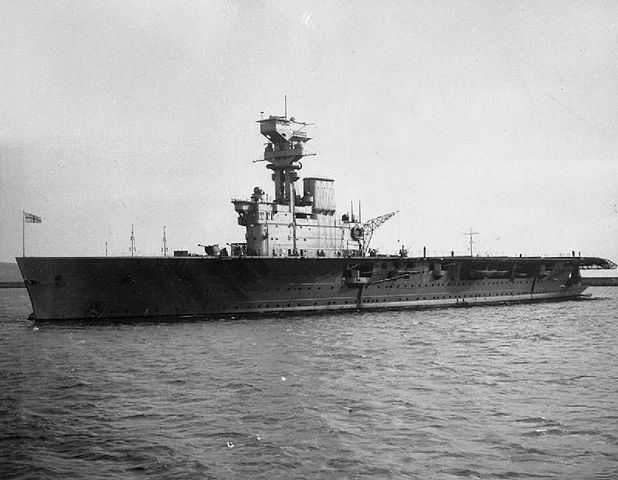
Hermes in 1938
Her aircraft searched for the ships Lady Southern Cross (Sir Charles Kingsford Smith) awaited at Singapore in November in an attempted speed record. Both the aircraft and crew disappeared, no trace was found after one month research. Hermes joined Hong Kong in March 1936 and the next month toured Japan with HMS Duncan and Delight as escorts. As usual she stayed in Wei Hai Wei and was back in HK in October. From January 1937 she accompanied the heavy cruiser HMS Dorsetshire and destroyers Duncan and Diana, and the fleet made a good will tour of the Dutch East Indies.
Her torpedo bombers multiplied exercises of mock torpedo attacks on HMS Cumberland and Dorsetshire in February in conjunction with the air group RAF Seletar in Singapore. She left on 17 March for Plymouth and participated in the Coronation Fleet Review at Spithead before joining the Reserve Fleet and training ship at Devonport in the summer. Already in 1937 her remaining single 4-inch guns were planned for replacement with two twin 4-inch and two octuple 2-pdr assisted by a single High-Angle Control System and 13,000 imperial gallons of aviation fuel. But the dockyard was too busy and the changes were postponed from July 1938 until September 1939, but war broke out and she was dispatched for her first war mission. These changes however would not have prevented her demise since the Japanese attack was overwhelming.
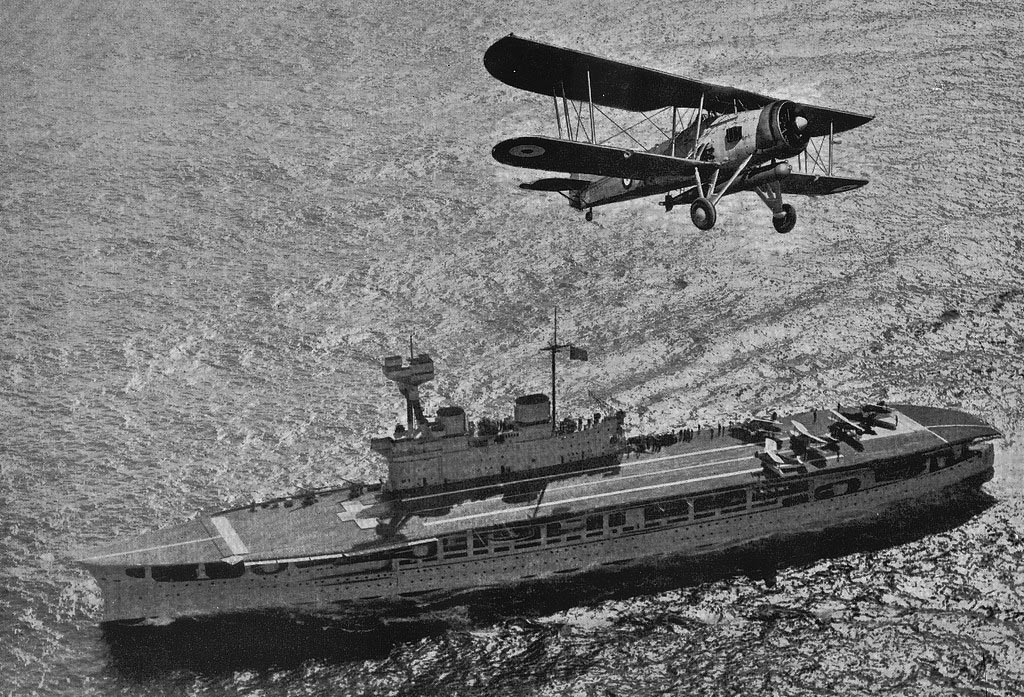
HMS Swordfish -Hms Eagle
1939 ASW patrols, western approaches:
Hermes was given a short refit in early August 1939 while Captain F. E. P. Hutton assumed command recommissioned on 24 August, and starting for her last prewar mission with 12 Fairey Swordfish TBs in board, of 814 Squadron. They arrived on the 1st of September, just as the war broke out. HMS Hermes started by conducting ASW patrols in the Western Approaches and from 18 September, as HMS Courageous was sunk, she located an U-Boat soon chased by her escorting DDs, HMS Isis and Imogen, but they failed to destroy it. Back to Devonport Hermes was fitted with a degaussing gear
Dakar, Force X, South Atlantic: Chasing blockade runners & commerce raiders:
On 7 October she joined the French battleship Strasbourg and sailed to Dakar (West Africa) on 16 October in what became the Franco-British Force X searching for German commerce raiders in the south Atlantic. She met no such threat until the end of December, escorting a convoy from South Africa back home where she was refitted from 9 January to 10 February 1940, and sailed back to to Dakar, resuming patrols and also looking for blockade runners, but without success.
Captain Richard F. J. Onslow took command of the ship on 25 May 1940. Hermes still made these patrols while in 29 June, the fall of France came here to modify plans, nine hours after the arrival of the new Governor of French Senegal, declaring his allegiance to the new Vichy French regime. Hermes was ordered to start of blockade of Dakar. On 7/8 July during the night, a boat from Hermes tried to drop four depth charges underneath French battleship Richelieu’s stern while Swordfish of 814 Squadron would attack by day. If the commando operation was successful as the boat indeed reached the battleship, the depth charges failed to explode, but the air torpedo attack was successful: One of the battleship’s propellers was badly damaged.
French aviation from Dakar would start a retaliatory attacks of Hermes several times, but scoring no hits. Back to Freetown, Hermes rammed en route the AMC HMS Corfu during a rainstorm in low visibility on 10 July. Three were injured, one would die later but Corfu’s men were unharmed, and the force of the collision was such both ships were locked together, eventually pulling apart. Hermes had 30 feet (9.1 m) of her bow squashed, but no lower hull damage, and she was able to sail to Freetown at 12 knots while Corfu was towed stern first by another ship. Hermes stayed in SAF for repairs at Simonstown dock from 17 August to 2 November and was back at Freetown on 29 November.

HMS Hermes and Dorsetshire, June 1940
St Helena, South Atlantic: Chasing commerce raiders: Light cruiser HMS Dragon joined the carrier on 2 December to resume their commerce raiders hunt in the South Atlantic operating from Saint Helena. Later they were joined by the armed merchant cruiser (AMC) HMS Pretoria Castle (later converted to a carrier) to search for KMS Admiral Scheer.
Eastern Africa: Blockading Vichy French: Back to Simonstown on 31 December, the force was sent due east, off the South African coast this time to hunt for Vichy French blockade runners. One was spotted on 26 January but made it safely in Madagascar. On 4 February she joined the heavy cruisers HMS Shropshire and HMS Hawkins to blockade Kismayo, Mali, a Vichy French-held port. Soon Commonwealth forces joined the siege while Hawkins would later captured three Italian merchantmen, Hermes one (12 February).
From 22 February, Hermes joined a fleet searching for KMS Admiral Scheer eventually spotted by an aircraft from HMS Glasgow. However she escaped. Hermes was then based in Colombo, Ceylon in March, still searching for Axis shipping, and sent to the Persian Gulf to cover the British attack on Basra in Iraq. She stayed there until mid-June and back to the Indian Ocean, patrolling between Ceylon and Seychelles Islands until 19 November.
Eastern Fleet: She made it back to Simonstown for a refit. She left the dockyard on 31 January 1942 to join the Eastern Fleet, based in Colombo from 14 February. Swordfish of 814 Squadron flew onboard, and she started her first mission with the destroyer HMAS Vampire for ASW patrols. In Trincomalee her squadron flew off and both ships sailed to Freemantle in Australia by mid-March. The Allied naval forces HQ was base there, but she departed once again to join Force B, Eastern Fleet. The greatest threat of course was the Japanese, and after the raid on Colombo Hermes and Vampire left Colombo for Trincomalee, preparing for Operation Ironclad, the British invasion of Madagascar.
The sinking of Hermes
Warning came of a Japanese air raid on 9 April 1942 while the ships were underway off Ceylon coast when they were spotted off Batticaloa by a Japanese reconnaissance plane from IJN Haruna. The radio spotting report was intercepted by British intelligence and both ships were ordered to return to Trincomalee fast. Meanwhile the fighter were scrambled to provide cover: These were six Fairey Fulmar II fighters of No. 273 Squadron RAF, and six other would arrive later from 803 and 806 Sqn, but their presence did not changed the outcome. This was the “British Pearl Harbour”.
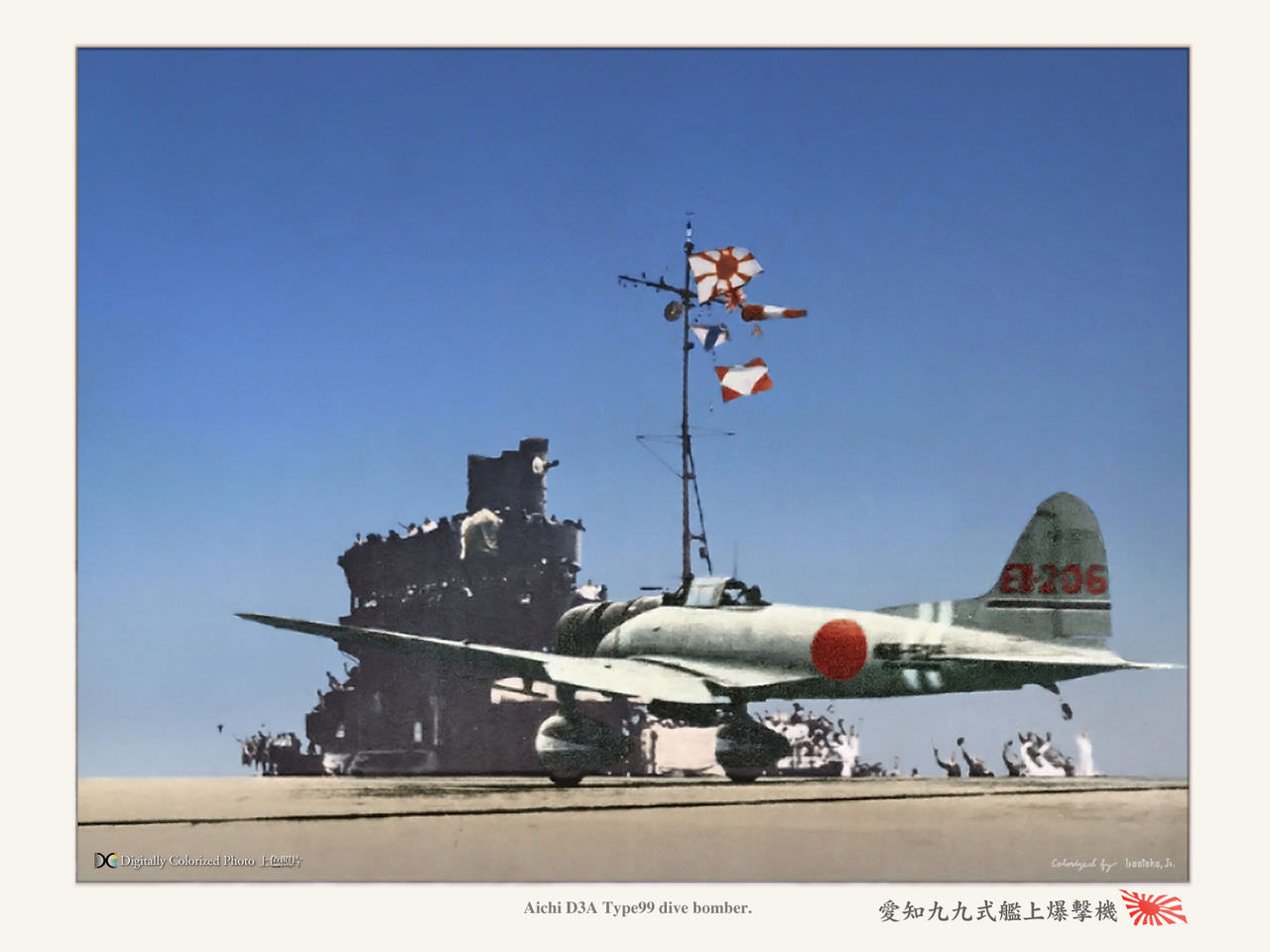
Aichi D3A dive bomber from IJN Kaga – colorized by Irootoko Jr.
Meanwhile indeed, 85 Aichi D3A dive bombers took off escorted by nine A6M Zero, and eventually 32 spotted both ships, while soon a furious battle started. Despite a deluge of AA, the dive bombers were really precise. Just like Stukas pilots, IJN pilots were already die-hard veterans of previous campaign, skillful and aggressive, and said to be able to place a bomb inside a funnel exhaust. Both the destroyers and carrier was relatively agile, and they manoeuvred wildly. But against a constant swarm of 32 planes which started they dive almost out of AA range, this was hopeless.
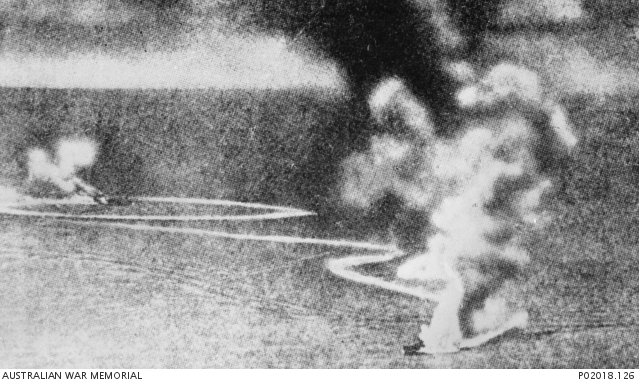
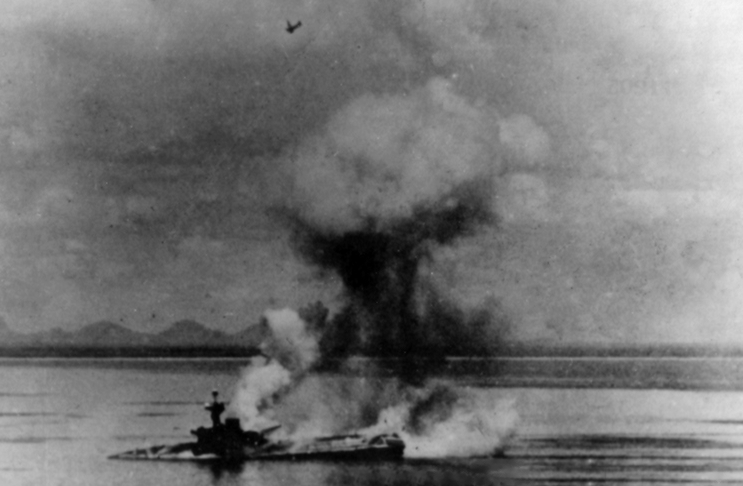
The sinking, shots by IJN planes: Both ships manoeuvering, trying to escape (Australian War Memorial), and the Hermes slowly sinking and burning.
As testified Stan Curtiss, an eyewitness account of “Dante’s inferno”:
“Suddenly there was an almighty explosion that seemed to lift us out of the water, the after magazine had gone up, then another, this time above us on the starboard side, from that moment onwards we had no further communication with the bridge which had received a direct hit, as a result of that our Captain and all bridge personnel were killed. Only about fifteen minutes had passed since the start of the action and the ship was already listing to port, fires were raging in the hanger, she was on fire from stem to stern, just aft of my gun position was the galley, that received a direct hit also, minutes later we had a near miss alongside our gun, talk about a tidal wave coming aboard, our crew were flung yards, tossed like corks on a pond. Picking myself up and finding no bones broken, I called out to each number of our crew and got an answer from all of them (no-one washed overboard), we were lucky; our gun was the only one that did not get hit. At this stage Hermes had a very heavy list to port and it was obvious that she was about to sink. As the sea was now only feet below our gun deck I gave the order “over the side lads, every man for himself, good luck to you all”.
The rest of the IJN air attack went further north and sunk also the RFA Athelstone (5,571 GRT), the corvette HMS Hollyhock (which exploded), oil tanker SS British Sergeant, Norwegian SS Norviken (2,924 GRT), and the carrier sank with the loss of 307 men and her Captain. HMS Vampire was also sunk and survivors were later picked up by the hospital ship Vita. In all the Japanese lost in this raid four D3As lost and two Fulmars were shot down by Zero fighters.
HMS Eagle (1924) |
|
| Dimensions | 203.5 x 35.1 m x 8.1 m (667 x 115 x 26 ft) |
| Displacement | 21,850 long tons standard, ? long tons FL |
| Crew | 791 |
| Propulsion | 4 shafts Parsons geared steam turbines, 24 Yarrow WT boilers |
| Speed | 24 knots (44 km/h; 28 mph) |
| Armor | Belt: 4.5 in (114 mm), Deck: 1–1.5 in (25–38 mm), Bulkheads: 4 in (102 mm) |
| Armament | 9 × 6-in (152 mm), 5 × 4-in (102 mm) Mk V AA |
| Aviation | Variable over time: 30 1924, 25 1942 |

Author’s profile of the Hermes in 1940
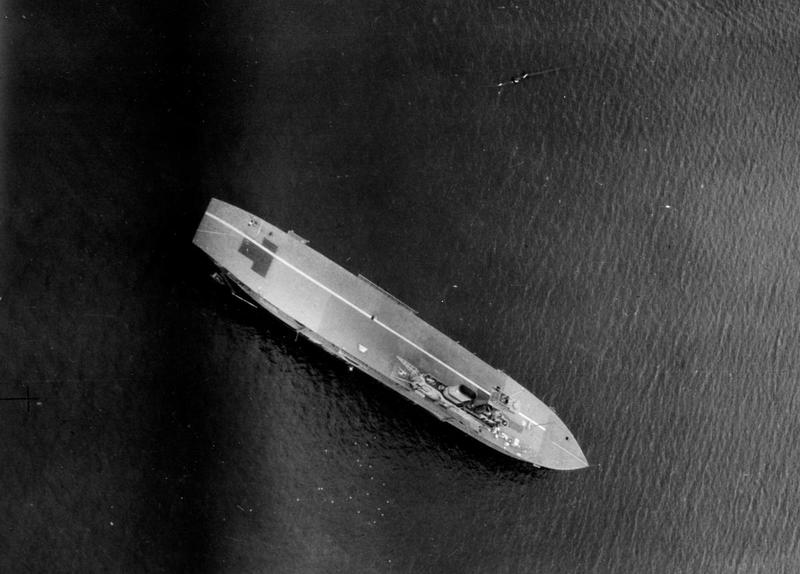
HMS Hermes II, Fleet Tender C or “Decoy Hermes”. SS Zealandic, the Marmari III, resold to the admiralty in 1939. She was taken in hands and converted in 1940 to make believe German intelligence that HMS Hermes was anchored at some place on the east coast of England. Both a fake flying deck was built in wood over the main deck, and a false island built in wooden frames and canvas on the side. When this was mission accomplished she was redesignated and on 4 June 1941, was due to join Chatham Dockyard in Kent to be converted back when she hit en route a submerged wreck off Norfolk. This did not happened by accident as she trained to manoeuver during a German aerial attack. Ships were sent there to tow her out of harm after being refloated, but E-boat got there first and crippled her. The damage was so intensive she was left there until the end of the war. This was a 8,090 GRT, 145.5 m long vessel by 19.2 m.
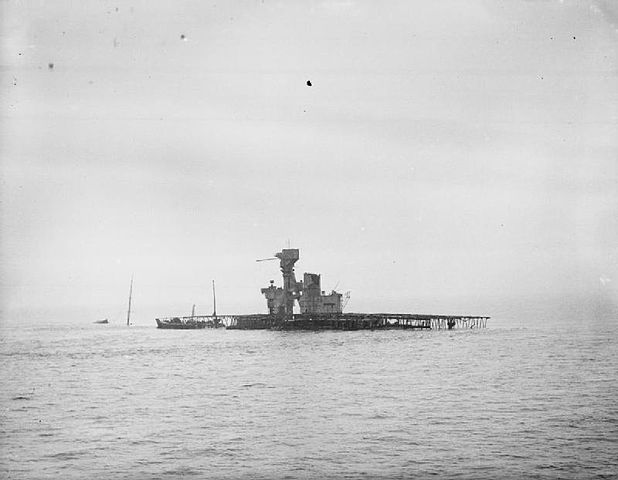
Another view of Fleet Tender C sunk, Shot from HMS Whaddon escorting a Convoy from 3 to 10 October 1941 to Sheerness.
Links – Read More
Gardiner, Robert and Gray, Randal, eds. (1985). Conway’s All the World’s Fighting Ships: 1906–21 & 1922-47
Colledge, J. J.; Warlow, Ben (2006) [1969]. Ships of the Royal Navy: The Complete Record
Friedman, Norman (1988). British Carrier Aviation: The Evolution of the Ships and Their Aircraft.
Rohwer, Jürgen (2005). Chronology of the War at Sea 1939–1945: The Naval History of World War Two (Third Rev ed.).
Sturtivant, Ray (1984). The Squadrons of the Fleet Air Arm.
google books – British CVs design, development and service ww2
//www.maritimequest.com/warship_directory/great_britain/pages/aircraft_carriers/
//en.wikipedia.org/wiki/HMS_Hermes_(95)
//dreadnoughtproject.org/tfs/index.php/H.M.S._Hermes_(1919)
//againstallodds.fandom.com/wiki/HMS_Hermes_(1919)
//thomo.coldie.net/tag/ww1/
//www.worldnavalships.com/hms_hermes.htm
//samilhistory.com/2017/12/07/dantes-inferno-recounting-south-african-sacrifice-on-the-hms-hermes/
//www.naval-history.net/xGM-Chrono-04CV-Hermes.htm
//www.bbc.co.uk/history/ww2peopleswar/stories/21/a4171321.shtml
//ww2db.com/ship_spec.php?ship_id=160
Video
HMS Hermes by Drachinfels
The models corner: HMS Hermes
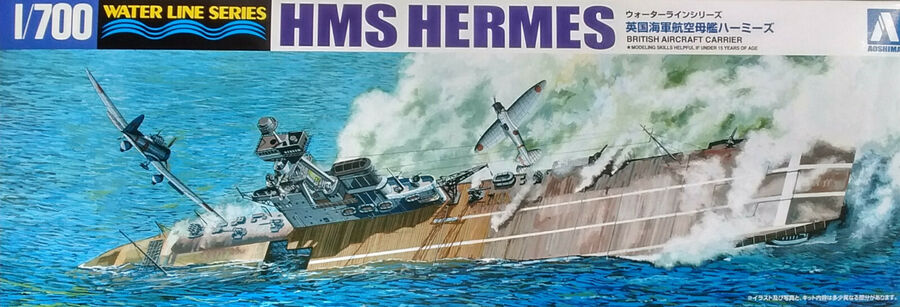
-Aoshima 1/700 wl kit Water Line Series HMS Hermes Indian Ocean 1942 livery
-HMS Hermes 1937 (Coronation Fleet Review) FlyHawk Model No. FH1126 1:700
Review of the latter kit


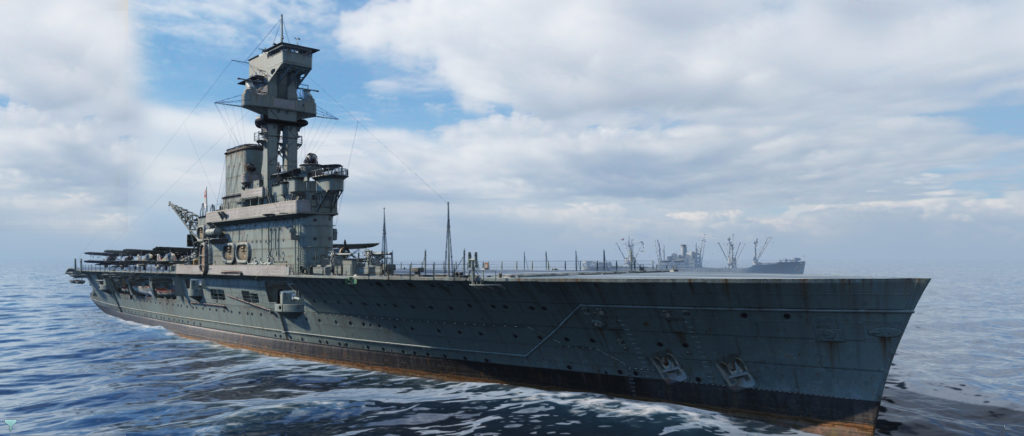
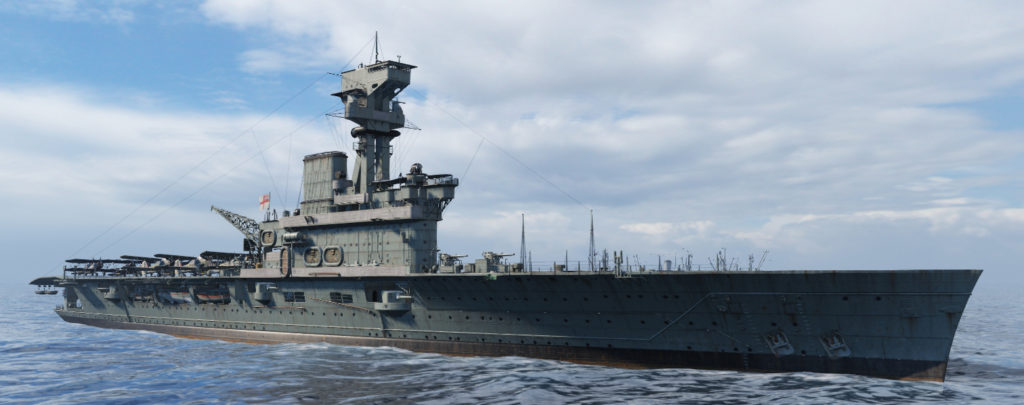
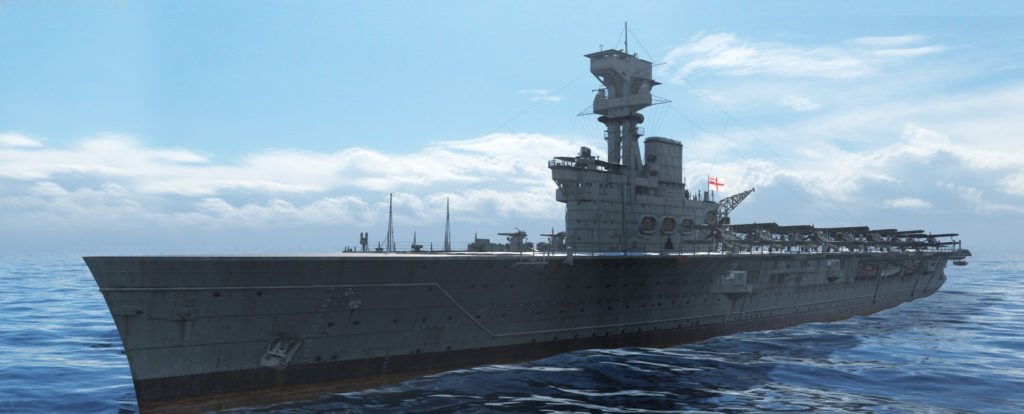
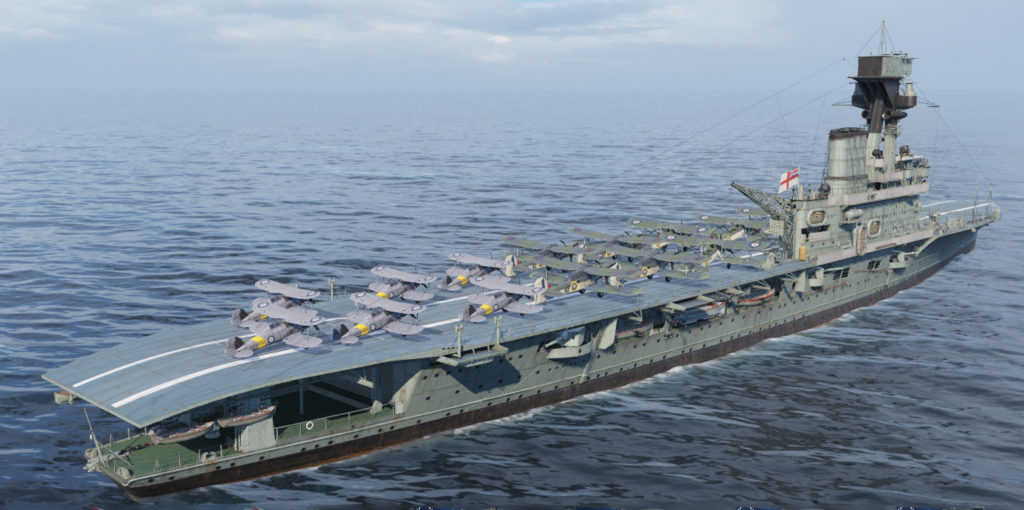
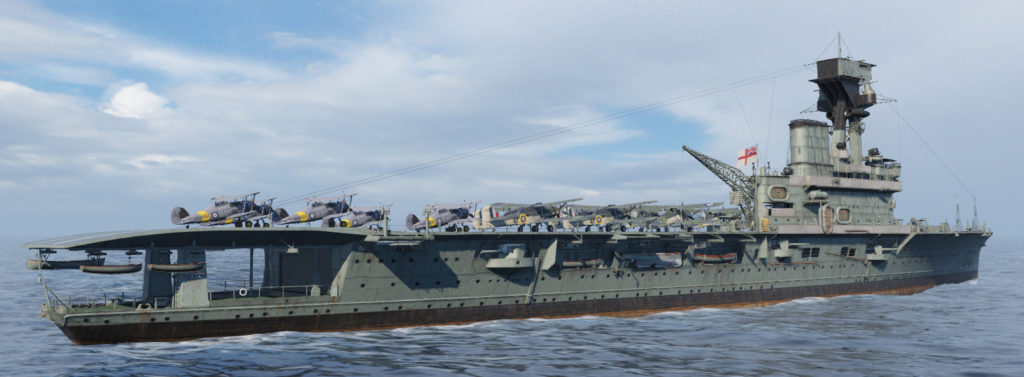
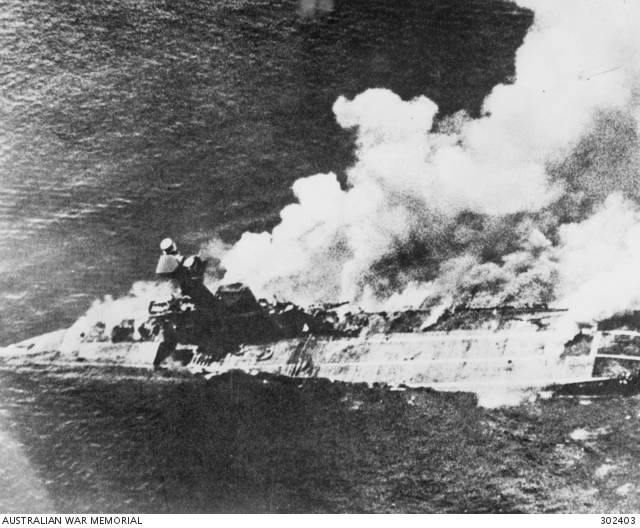
 Latest Facebook Entry -
Latest Facebook Entry -  X(Tweeter) Naval Encyclopedia's deck archive
X(Tweeter) Naval Encyclopedia's deck archive Instagram (@navalencyc)
Instagram (@navalencyc)





 French Navy
French Navy Royal Navy
Royal Navy Russian Navy
Russian Navy Armada Espanola
Armada Espanola Austrian Navy
Austrian Navy K.u.K. Kriegsmarine
K.u.K. Kriegsmarine Dansk Marine
Dansk Marine Nautiko Hellenon
Nautiko Hellenon Koninklije Marine 1870
Koninklije Marine 1870 Marinha do Brasil
Marinha do Brasil Osmanlı Donanması
Osmanlı Donanması Marina Do Peru
Marina Do Peru Marinha do Portugal
Marinha do Portugal Regia Marina 1870
Regia Marina 1870 Nihhon Kaigun 1870
Nihhon Kaigun 1870 Preußische Marine 1870
Preußische Marine 1870 Russkiy Flot 1870
Russkiy Flot 1870 Svenska marinen
Svenska marinen Søværnet
Søværnet Union Navy
Union Navy Confederate Navy
Confederate Navy Armada de Argentina
Armada de Argentina Imperial Chinese Navy
Imperial Chinese Navy Marinha do Portugal
Marinha do Portugal Mexico
Mexico Kaiserliche Marine
Kaiserliche Marine 1898 US Navy
1898 US Navy Sovietskiy Flot
Sovietskiy Flot Royal Canadian Navy
Royal Canadian Navy Royal Australian Navy
Royal Australian Navy RNZN Fleet
RNZN Fleet Chinese Navy 1937
Chinese Navy 1937 Kriegsmarine
Kriegsmarine Chilean Navy
Chilean Navy Danish Navy
Danish Navy Finnish Navy
Finnish Navy Hellenic Navy
Hellenic Navy Polish Navy
Polish Navy Romanian Navy
Romanian Navy Turkish Navy
Turkish Navy Royal Yugoslav Navy
Royal Yugoslav Navy Royal Thai Navy
Royal Thai Navy Minor Navies
Minor Navies Albania
Albania Austria
Austria Belgium
Belgium Columbia
Columbia Costa Rica
Costa Rica Cuba
Cuba Czechoslovakia
Czechoslovakia Dominican Republic
Dominican Republic Haiti
Haiti Hungary
Hungary Honduras
Honduras Estonia
Estonia Iceland
Iceland Eire
Eire Equador
Equador Iran
Iran Iraq
Iraq Latvia
Latvia Liberia
Liberia Lithuania
Lithuania Mandchukuo
Mandchukuo Morocco
Morocco Nicaragua
Nicaragua Persia
Persia San Salvador
San Salvador Sarawak
Sarawak Uruguay
Uruguay Venezuela
Venezuela Zanzibar
Zanzibar Warsaw Pact Navies
Warsaw Pact Navies Bulgaria
Bulgaria Hungary
Hungary

 Bundesmarine
Bundesmarine Dutch Navy
Dutch Navy Hellenic Navy
Hellenic Navy Marina Militare
Marina Militare Yugoslav Navy
Yugoslav Navy Chinese Navy
Chinese Navy Indian Navy
Indian Navy Indonesian Navy
Indonesian Navy JMSDF
JMSDF North Korean Navy
North Korean Navy Pakistani Navy
Pakistani Navy Philippines Navy
Philippines Navy ROKN
ROKN Rep. of Singapore Navy
Rep. of Singapore Navy Taiwanese Navy
Taiwanese Navy IDF Navy
IDF Navy Saudi Navy
Saudi Navy Royal New Zealand Navy
Royal New Zealand Navy Egyptian Navy
Egyptian Navy South African Navy
South African Navy






























 Ukrainian Navy
Ukrainian Navy dbodesign
dbodesign
I am the tec deep trimix instructor who re discovered the lost wreck
If you wish to have some pictures I can send you.
I do group dive trips with Tec divers
Thanks
feli Master instructor
Tec deep trimix instructor
Thx Felician. That might be useful indeed to have a wreck survey gallery, please, do so ! In doubt, check the contact page for the gmail address.